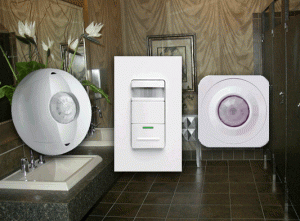Occupancy Sensors Save Electricity | Leviton | Energy Savings
Energy conservation is rapidly being realized as a viable way to cut expenses and add positive cash flow to any business or home budget. In the growing popularity of Compact Fluorescent Lamps and LED Light bulbs, one other great investment is Occupancy Sensors. Lighting is typically the single largest users of electricity in a commercial building. Occupancy Sensors, commonly referred to as an “Occ Sensor” are installed to turn lighting on when a person approaches or enters a room, and have a built in, programmable time delay to turn the lighting circuit off after a brief period of time. Over the past few years, this technology has changed to incorporate a wide variety of sensors for use in many residential and commercial applications.
 One of the biggest drawbacks in years past was the use in commercial bathrooms. If a bathroom stall was in use, the partitions would block the sensor from detecting that there was an occupant in the restroom, and the lights may turn out while the bathroom is still in use. Often perople would find themselves waving a hand over the stall door to try and activate the sensor again. This problem has been rectified with the creation of a “Nocc Sensor”, or Noise and Heat Activated Switch. The Nocc Sensor has a decibel rated noise sensor capable of detecting so much as a murmur or footstep, preventing it from turning off even if direct view of an occupant is blocked.
One of the biggest drawbacks in years past was the use in commercial bathrooms. If a bathroom stall was in use, the partitions would block the sensor from detecting that there was an occupant in the restroom, and the lights may turn out while the bathroom is still in use. Often perople would find themselves waving a hand over the stall door to try and activate the sensor again. This problem has been rectified with the creation of a “Nocc Sensor”, or Noise and Heat Activated Switch. The Nocc Sensor has a decibel rated noise sensor capable of detecting so much as a murmur or footstep, preventing it from turning off even if direct view of an occupant is blocked.
Where should you use an Occupancy Sensor?
Residential: Occupancy sensors should be used in areas that are not normally occupied for extended periods of time. Use of an occupancy sensor in a Bathroom, Closet, Garage, Laundry Room and other low use areas can provide added sensor of luxury with hands free switching as well as ensuring non priority lights do not remain on when not in use. Children often leave these lights on, so the use of the occupancy sensor corrects bad habits affordably.
Commercial: We recommend a (2) Visit Rule. Besides Bathrooms which are an almost given in a commercial building, the two visit rule is the best way to judge Occ Sensor usage. How this rule works is simple. Perform a walk through inspection of your facility. If you enter a space, room or area that lights are on and no one is occupying that space at any two given times during your walk through, it is likely a great place to install an occupancy sensor. Primary considerations should be placed in:
- Independent Offices where the user works in and out regularly
- Warehouse Isles and Back Room Areas
- Conference, Meeting Rooms
- Storage or Supply Areas
- Bathrooms
- Stair Wells and Corridors
How much electricity is saved by an occupancy sensor?
Saving electricity by use of an occupancy sensor is very hard to calculate precisely, but should result in a 50%-90% reduction in usage. The following example should help you understand the principle. If a bathroom uses (3) 2×4 fluorescent fixtures is left on during an 8 hour day, the cost of electricity is approximately $112.93 per year. By installing an Occupancy Sensor (Average cost $30.00) the lights in the bathroom may be cut down to as low as 1.5 hours per day. The resulting savings would be $91.76 per year. Times an average switch life of 10 years is equal to a positive cash flow of $917.60. Return on investment is an average of 4.2 months. By using Occupancy sensors in multiple areas, a business can reduce its electricity expenses measurably.
For more information on using Occupancy Sensors view our website or call Synergy Lighting for a free consultation and walk through.
Phone: (941)-756-4844
Toll Free: (877) 220-5483
e-mail: sales@synergylightingusa.com

